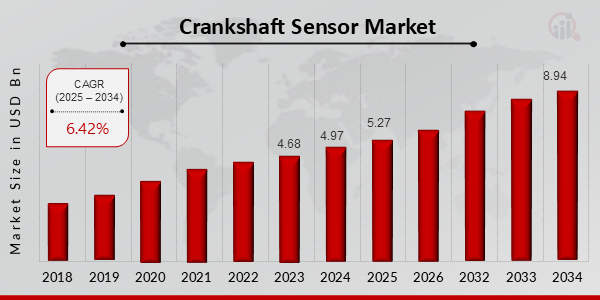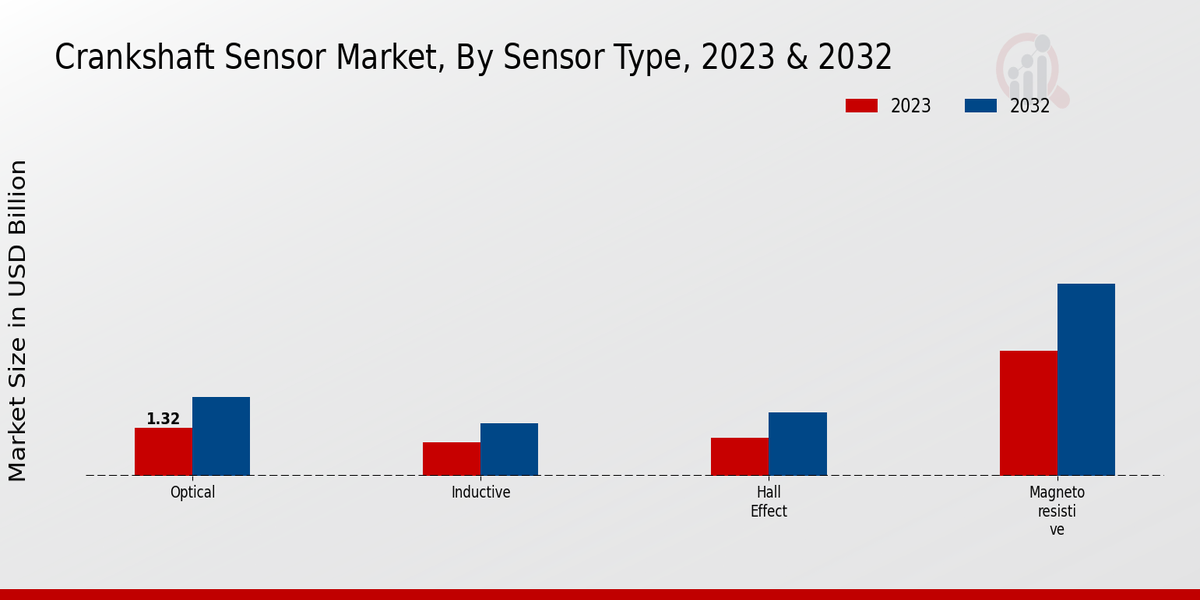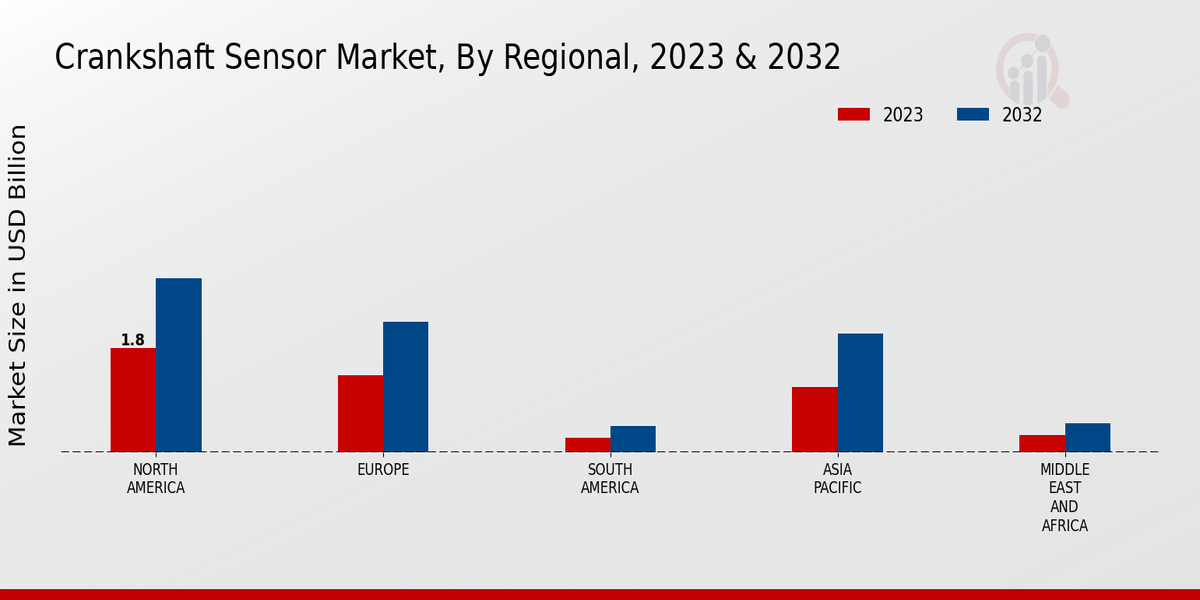Crankshaft Sensor Market Overview
Crankshaft Sensor Market is projected to grow from USD 5.27 Billion in 2025 to USD 8.94 Billion by 2034, exhibiting a compound annual growth rate (CAGR) of 6.42% during the forecast period (2025 - 2034). Additionally, the market size for Crankshaft Sensor Market was valued at USD 4.97 billion in 2024.
Key Crankshaft Sensor Market Trends Highlighted
The increasing demand for efficient and reliable automotive engines is driving the growth of the Crankshaft Sensor Market. Crankshaft sensors play a crucial role in engine management systems, providing accurate information about the crankshaft's position and speed. The growing adoption of electronic engine management systems, particularly in emerging markets, is fueling the demand for crankshaft sensors. Moreover, the need for improved fuel efficiency and reduced emissions is helping the development of advanced crankshaft sensors with higher precision and accuracy.
Key market drivers include the rising production and sales of passenger and commercial vehicles, the adoption of stringent emission regulations, and technological advancements in engine management systems. Opportunities lie in the expanding aftermarket for crankshaft sensors, the growing popularity of electric and hybrid vehicles, and the development of wireless crankshaft sensors. Recent trends include the increasing use of magnetoresistive sensors, the integration of sensors with other engine components, and the adoption of advanced materials for improved performance and reliability.
Figure1: Crankshaft Sensor Market, 2025 - 2034

Source: Primary Research, Secondary Research, MRFR Database and Analyst Review
Crankshaft Sensor Market Drivers
Rising Demand for Advanced Engine Management Systems
The increasing demand for advanced engine management systems is a major driver for the growth of the Crankshaft Sensor Market Industry. These systems rely on crankshaft sensors to provide accurate and real-time data on engine performance, enabling precise control of fuel injection, ignition timing, and other critical parameters. As vehicles become more sophisticated and efficient, the need for advanced engine management systems will continue to grow, driving demand for crankshaft sensors.
Growing Adoption of Electric and Hybrid Vehicles
The increasing adoption of electric and hybrid vehicles is another key driver for the Crankshaft Sensor Market Industry. Electric and hybrid vehicles require crankshaft sensors to monitor engine speed and position, even when the internal combustion engine is not running. As the demand for electric and hybrid vehicles rises, the demand for crankshaft sensors is expected to grow accordingly.
Government Regulations on Emissions and Fuel Efficiency
Government regulations on emissions and fuel efficiency are also driving the growth of the Crankshaft Sensor Market Industry. Crankshaft sensors play a crucial role in ensuring that vehicles meet these regulations by providing accurate data on engine performance. As governments worldwide implement stricter emissions and fuel efficiency standards, the demand for crankshaft sensors is expected to increase.
Crankshaft Sensor Market Segment Insights
Crankshaft Sensor Market Sensor Type Insights
The Crankshaft Sensor Market is segmented by Sensor Type into Magnetoresistive, Hall Effect, Inductive, and Optical. In 2023, the Magnetoresistive segment held the largest market share of around 45%. This is attributed to its high accuracy, sensitivity, and reliability. The Hall Effect segment is expected to witness the highest growth rate during the forecast period, owing to its low cost and compact size. The Inductive segment accounted for a significant market share in 2023, primarily due to its ability to detect both ferrous and non-ferrous metals.
The rising demand for advanced engine management systems and the increasing adoption of electronic throttle controls are key factors driving the growth of the market. Additionally, the growing popularity of hybrid and electric vehicles is further propelling the demand for crankshaft sensors. Asia-Pacific is expected to remain the largest regional market for crankshaft sensors throughout the forecast period, owing to the presence of major automotive manufacturing hubs in countries such as China, India, and Japan. North America and Europe are also significant markets for crankshaft sensors, with well-established automotive industries.
Key industry participants in the Crankshaft Sensor Market include Bosch, Continental, Denso, Delphi Technologies, and Sensata Technologies. These companies are investing heavily in research and development to enhance the performance and reliability of their products. Strategic partnerships, mergers, and acquisitions are also common strategies adopted by market players to expand their market presence and gain a competitive edge.
Figure2: Crankshaft Sensor Market, By Sensor Type, 2023 & 2032

Source: Primary Research, Secondary Research, MRFR Database and Analyst Review
Crankshaft Sensor Market Vehicle Type Insights
The Crankshaft Sensor Market is segmented by Vehicle Type into Passenger Cars, Commercial Vehicles, and Off-Highway Vehicles.
Among these segments, Passenger Cars held the largest market share in 2023, accounting for around 55% of the Crankshaft Sensor Market revenue. The growth of this segment can be attributed to the increasing production and sales of passenger cars worldwide. Commercial Vehicles are expected to witness a significant growth rate during the forecast period due to the rising demand for goods transportation and logistics services. Off-highway vehicles are projected to have a steady growth rate over the forecast period, driven by the increasing popularity of outdoor recreational activities and the growing construction industry.
Crankshaft Sensor Market Engine Type Insights
The Engine Type segment plays a crucial role in the Crankshaft Sensor Market. In 2023, the Gasoline engine segment held the dominant market share of around 45%, owing to the extensive use of gasoline-powered vehicles globally. Diesel engines are also widely used, particularly in commercial vehicles and heavy-duty applications, accounting for approximately 30% of the market share. Hybrid and Electric engine segments are gaining traction due to increasing environmental concerns and government regulations promoting fuel efficiency. The Hybrid engine segment is projected to witness substantial growth in the coming years, driven by the rising demand for fuel-efficient vehicles. Electric vehicles, while still a relatively small segment, are expected to experience exponential growth in the long term as governments and consumers embrace sustainable transportation solutions.
Crankshaft Sensor Market Application Insights
The Crankshaft Sensor Market segmentation by Application can be divided into Engine Speed Monitoring, Engine Timing Control, Knock Detection, and Others. In 2023, the Engine Speed Monitoring segment held the largest market share at 35.4%, followed by Engine Timing Control at 28.1%, Knock Detection at 22.3%, and Others at 14.2%. The Engine Speed Monitoring segment is expected to continue to dominate the market during the forecast period, with a projected market share of 36.1% by 2032. The growth of this segment can be attributed to the increasing demand for accurate engine speed monitoring systems in various industries, including automotive, aerospace, and industrial machinery. The Engine Timing Control segment is also expected to witness significant growth during the forecast period, owing to the growing need for precise engine timing control to improve engine performance and efficiency.
Crankshaft Sensor Market Regional Insights
The regional segment of the Crankshaft Sensor Market is expected to witness significant growth over the forecast period, with North America and Europe leading the market. North America is anticipated to hold the largest market share due to the presence of major automotive manufacturers and a high demand for advanced vehicle technologies. Europe is expected to follow closely, driven by stringent emission regulations and a growing focus on fuel efficiency. APAC is projected to exhibit the fastest growth rate, owing to the increasing production of vehicles in the region.South America and MEA are also expected to contribute to the overall market growth, although at a slower pace. The Crankshaft Sensor Market is expected to reach USD 4.43 billion in 2023 and USD 7.5 billion by 2032, exhibiting a CAGR of 6.04% during the forecast period.
Figure3: Crankshaft Sensor Market, By Regional, 2023 & 2032

Source: Primary Research, Secondary Research, MRFR Database and Analyst Review
Crankshaft Sensor Market Key Players And Competitive Insights
Major players in the Crankshaft Sensor Market industry are continuously focusing on developing innovative and advanced products to meet the evolving needs of customers. Leading Crankshaft Sensor Market players are investing heavily in research and development activities to enhance the performance and functionality of their products. The Crankshaft Sensor Market development process involves collaboration with research institutions and universities to gain access to the latest technologies and advancements. Competitive Landscape of Crankshaft Sensor Market is highly fragmented, with numerous players operating in regional and global markets. Key players are adopting various strategies such as mergers and acquisitions, partnerships, and joint ventures to expand their market presence and gain competitive advantage.
Continental AG, a leading company in the Crankshaft Sensor Market, offers a wide range of crankshaft sensors for various automotive applications. The company is known for its innovative sensor technologies and high-quality products. Continental AG has a strong global presence and caters to a diverse customer base. The company is focused on sustainable development and incorporates eco-friendly practices into its operations.
Bosch, a major competitor in the Crankshaft Sensor Market, is a globally recognized automotive supplier. The company provides a comprehensive portfolio of crankshaft sensors designed to meet the specific requirements of different vehicle manufacturers. Bosch has a strong focus on research and development, and its sensors are known for their precision, reliability, and durability. The company has a wide distribution network and offers excellent customer support.
Key Companies in the Crankshaft Sensor Market Include
-
Mitsuba Corporation
-
Bosch
-
Mitsubishi Electric
-
Hyundai Mobis
-
NTK
-
Aisin Seiki
-
Murata Manufacturing
-
Hitachi
-
Denso
-
Sensata Technologies
-
Continental
-
Delphi
-
Omron Corporation
-
Alps Electric
-
TDK Corporation
Crankshaft Sensor Market Industry Developments
The Crankshaft Sensor Market is projected to reach a value of USD 7.5 billion by 2032, exhibiting a CAGR of 6.04% during the forecast period (2024-2032).Recent market developments include collaborations and partnerships between key players to enhance product offerings and expand market reach. For instance, in 2023, Infineon Technologies AG and HELLA announced a collaboration to develop and produce advanced crankshaft sensors for automotive applications.Ongoing technological advancements are driving market growth, such as the development of sensors with improved accuracy, durability, and resistance to harsh operating conditions. The rising demand for fuel-efficient and environmentally friendly vehicles is also contributing to market growth, as crankshaft sensors play a crucial role in optimizing engine performance and reducing emissions.
Crankshaft Sensor Market Segmentation Insights
Crankshaft Sensor Market Sensor Type Outlook
- Magnetoresistive
- Hall Effect
- Inductive
- Optical
Crankshaft Sensor Market Vehicle Type Outlook
- Passenger Cars
- Commercial Vehicles
- Off-Highway Vehicles
Crankshaft Sensor Market Engine Type Outlook
- Gasoline
- Diesel
- Hybrid
- Electric
Crankshaft Sensor Market Application Outlook
- Engine Speed Monitoring
- Engine Timing Control
- Knock Detection
- Other
Crankshaft Sensor Market Regional Outlook
- North America
- Europe
- South America
- Asia-Pacific
- Middle East and Africa
|
Report Attribute/Metric
|
Details
|
|
Market Size 2024
|
4.97 (USD Billion)
|
|
Market Size 2025
|
5.27 (USD Billion)
|
|
Market Size 2034
|
8.94 (USD Billion)
|
|
Compound Annual Growth Rate (CAGR)
|
6.42% (2025 - 2034)
|
|
Report Coverage
|
Revenue Forecast, Competitive Landscape, Growth Factors, and Trends
|
|
Base Year
|
2024
|
|
Market Forecast Period
|
2025 - 2034
|
|
Historical Data
|
2019 - 2023
|
|
Market Forecast Units
|
USD Billion
|
| Key Companies Profiled |
Mitsuba Corporation, Bosch, Mitsubishi Electric, Hyundai Mobis, NTK, Aisin Seiki, Murata Manufacturing, Hitachi, Denso, Sensata Technologies, Continental, Delphi, Omron Corporation, Alps Electric, TDK Corporation |
| Segments Covered |
Sensor Type, Vehicle Type, Engine Type, Application, Regional |
| Key Market Opportunities |
Rising Demand for Fuel-Efficient Vehicles Increasing Adoption of Advanced Engine Technologies Growing Focus on Vehicle Safety Expansion into Developing Markets and Technological Advancements |
| Key Market Dynamics |
Growing demand for high-performance engines, stringent emission regulations, technological advancements, increasing vehicle production and widespread adoption of advanced driver-assistance systems. |
| Countries Covered |
North America, Europe, APAC, South America, MEA |
Frequently Asked Questions (FAQ) :
The Crankshaft Sensor Market is expected to reach a valuation of approximately 4.68 billion USD in 2023.
The Crankshaft Sensor Market is projected to grow at a CAGR of approximately 6.42% from 2025 to 2034.
The Crankshaft Sensor Market is expected to reach a valuation of approximately 8.94 billion USD by 2034.
The automotive segment accounted for the largest market share in the Crankshaft Sensor Market in 2023.
Some of the key competitors in the Crankshaft Sensor Market include Bosch, Continental, Delphi, Denso, and Hyundai Mobis.
Some of the key trends driving the growth of the Crankshaft Sensor Market include the increasing demand for fuel-efficient and low-emission vehicles, the growing adoption of advanced driver assistance systems (ADAS), and the increasing popularity of electric vehicles.
Some of the challenges facing the Crankshaft Sensor Market include the high cost of raw materials, the intense competition in the market, and the stringent government regulations.
Some of the opportunities for growth in the Crankshaft Sensor Market include the increasing demand for vehicles in emerging markets, the growing adoption of autonomous vehicles, and the development of new and innovative sensor technologies.
Some of the key strategies adopted by players in the Crankshaft Sensor Market include product innovation, strategic partnerships, and mergers and acquisitions.


















